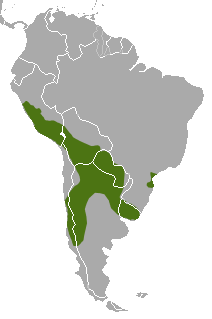Molina's hog-nosed skunk
This is an old revision of this page, as edited by Tom.Reding (talk | contribs) at 01:49, 11 October 2020 (last-author-amp=y/yes → name-list-style=amp; WP:GenFixes on). The present address (URL) is a permanent link to this revision, which may differ significantly from the current revision.
| Molina's hog-nosed skunk | |
|---|---|

| |
| Scientific classification | |
| Domain: | Eukaryota |
| Kingdom: | Animalia |
| Phylum: | Chordata |
| Class: | Mammalia |
| Order: | Carnivora |
| Family: | Mephitidae |
| Genus: | Conepatus |
| Species: | C. chinga
|
| Binomial name | |
| Conepatus chinga (Molina, 1782)
| |

| |
| Molina's hog-nosed skunk range | |
Molina's hog-nosed skunk (Conepatus chinga) is similar to the common skunk with scent glands used to spray an odorous liquid to offend potential predators. They have a resistance to pit viper venom, distinct thin white markings and a pink, hog-like, fleshy nose.
Habitat
The Molina's hog-nosed skunk's native range is throughout mid to southern South America, Chile, Peru, northern Argentina, Bolivia, Paraguay, Uruguay, and southern Brazil.[2] The mammal is therefore associated with temperate regions and open areas, mainly described as the Pampas biome[3] and preferring to live in open vegetation, shrub forest and rocky sloped areas.[2]
Population and distribution
Typically they will live alone in an average home range size of about 1.66 individuals/km² with some overlapping and about six skunks per 3.5 km².[4] Although living in mostly solitary areas, the skunks will come together temporarily for mating purposes.[2]
Diet
Foraging mainly at night, the skunk is omnivorous eating birds, small mammals, eggs, insects, leaves, and fruit. The tooth morphology in the Molina's hog-nosed skunk, is different than most mammals in that their teeth are adapted to their omnivorous diet with grinding being the main function of the carnassial apparatus.[5]
Conservation status
The skunk is listed as "least concerned" according to the IUCN Redlist. The main threats of the skunk are increased habitat destruction and fragmentation[6] from over exploitation of humans and grazing of agriculture. The skunk is also affected by the planning of new roads and road-kills. Due to improper planning, habitat destruction, and fragmentation, the skunk has started living around man-made structures and along fences and buildings.[6]
References
- ^ Emmons, L. & Helgen, K. (2008). "Conepatus chinga". IUCN Red List of Threatened Species. 2008. Retrieved 27 January 2009.
{{cite journal}}: Invalid|ref=harv(help){{cite iucn}}: old-form url (help) - ^ a b c [Afflerbaugh, K. 2002. "Conepatus chinga" (On-line), Animal Diversity Web. Accessed September 10, 2013 at http://animaldiversity.ummz.umich.edu/accounts/Conepatus_chinga/]
- ^ [Kasper, C. B, et al. "Differential patterns of home-range, net displacement and resting sites use of Conepatus chinga in southern Brazil. Mammalian Biology 77 (2012): 358-362. Academic Search Complete. Web. 14 October. 2013.]
- ^ [Castillo, D.F., et al. "Spatial organization of Molina's hog-nosed skunk (Conepatus chinga) in two landscapes of the Pampas grassland of Argentina." Canadian Journal of Zoology 89 (2011): 229-238. Academic Search Complete. Web. 14 October. 2013]
- ^ [Felipe Bortolotto, et al. "Feeding Habits of Molina's Hog-Nosed Skunk, Conepatus Chinga (Carnivora: Mephitidae) In The Extreme South of Brazil." Zoologia (Curitiba) 2 (2011): 193. Directory of Open Access Journals. Web. 10 Sept. 2013.]
- ^ a b [Castillo, D.F., et al. 2011. "Denning ecology of Molina's hog-nosed skunk in a farmland area in the Pampas grassland of Argentina." The Ecological Society of Japan 26: 845-850. Academic Search Complete. Web. 7 November. 2013.]
- The Andes: A Trekking Guide
External links
Extant Carnivora species | |||||||||||||||||||||||||||||||||||||||||||||||||||||||||||||||||||
|---|---|---|---|---|---|---|---|---|---|---|---|---|---|---|---|---|---|---|---|---|---|---|---|---|---|---|---|---|---|---|---|---|---|---|---|---|---|---|---|---|---|---|---|---|---|---|---|---|---|---|---|---|---|---|---|---|---|---|---|---|---|---|---|---|---|---|---|
| |||||||||||||||||||||||||||||||||||||||||||||||||||||||||||||||||||
| |||||||||||||||||||||||||||||||||||||||||||||||||||||||||||||||||||
| |||||||||||||||||||||||||||||||||||||||||||||||||||||||||||||||||||
| |||||||||||||||||||||||||||||||||||||||||||||||||||||||||||||||||||
| |||||||||||||||||||||||||||||||||||||||||||||||||||||||||||||||||||
| |||||||||||||||||||||||||||||||||||||||||||||||||||||||||||||||||||
| |||||||||||||||||||||||||||||||||||||||||||||||||||||||||||||||||||
| |||||||||||||||||||||||||||||||||||||||||||||||||||||||||||||||||||
| Conepatus chinga | |
|---|---|

